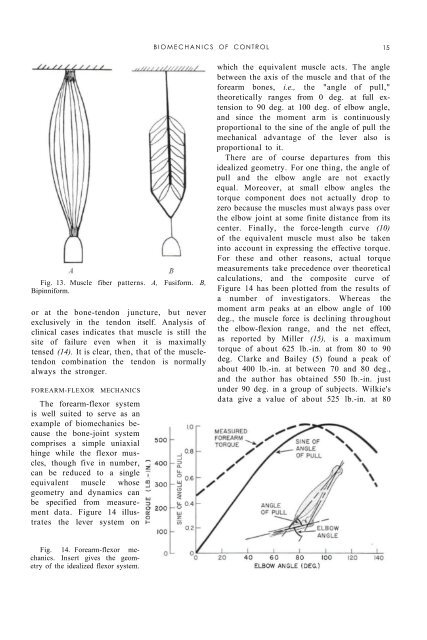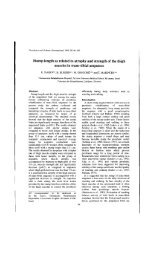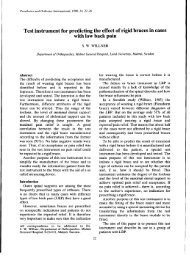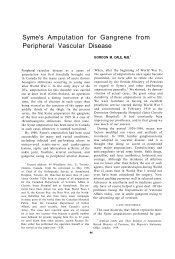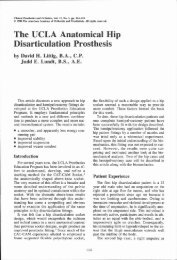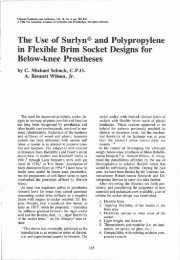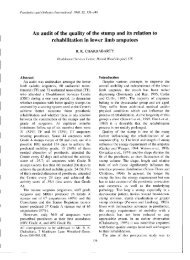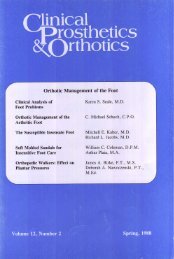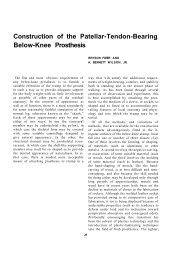The Biomechanics of Control in Upper-Extremity Prostheses
The Biomechanics of Control in Upper-Extremity Prostheses
The Biomechanics of Control in Upper-Extremity Prostheses
You also want an ePaper? Increase the reach of your titles
YUMPU automatically turns print PDFs into web optimized ePapers that Google loves.
BIOMECHANICS OF CONTROL 15<br />
Fig. 13. Muscle fiber patterns. A, Fusiform. B,<br />
Bip<strong>in</strong>niform.<br />
or at the bone-tendon juncture, but never<br />
exclusively <strong>in</strong> the tendon itself. Analysis <strong>of</strong><br />
cl<strong>in</strong>ical cases <strong>in</strong>dicates that muscle is still the<br />
site <strong>of</strong> failure even when it is maximally<br />
tensed (14). It is clear, then, that <strong>of</strong> the muscletendon<br />
comb<strong>in</strong>ation the tendon is normally<br />
always the stronger.<br />
FOREARM-FLEXOR MECHANICS<br />
<strong>The</strong> forearm-flexor system<br />
is well suited to serve as an<br />
example <strong>of</strong> biomechanics because<br />
the bone-jo<strong>in</strong>t system<br />
comprises a simple uniaxial<br />
h<strong>in</strong>ge while the flexor muscles,<br />
though five <strong>in</strong> number,<br />
can be reduced to a s<strong>in</strong>gle<br />
equivalent muscle whose<br />
geometry and dynamics can<br />
be specified from measurement<br />
data. Figure 14 illustrates<br />
the lever system on<br />
which the equivalent muscle acts. <strong>The</strong> angle<br />
between the axis <strong>of</strong> the muscle and that <strong>of</strong> the<br />
forearm bones, i.e., the "angle <strong>of</strong> pull,"<br />
theoretically ranges from 0 deg. at full extension<br />
to 90 deg. at 100 deg. <strong>of</strong> elbow angle,<br />
and s<strong>in</strong>ce the moment arm is cont<strong>in</strong>uously<br />
proportional to the s<strong>in</strong>e <strong>of</strong> the angle <strong>of</strong> pull the<br />
mechanical advantage <strong>of</strong> the lever also is<br />
proportional to it.<br />
<strong>The</strong>re are <strong>of</strong> course departures from this<br />
idealized geometry. For one th<strong>in</strong>g, the angle <strong>of</strong><br />
pull and the elbow angle are not exactly<br />
equal. Moreover, at small elbow angles the<br />
torque component does not actually drop to<br />
zero because the muscles must always pass over<br />
the elbow jo<strong>in</strong>t at some f<strong>in</strong>ite distance from its<br />
center. F<strong>in</strong>ally, the force-length curve (10)<br />
<strong>of</strong> the equivalent muscle must also be taken<br />
<strong>in</strong>to account <strong>in</strong> express<strong>in</strong>g the effective torque.<br />
For these and other reasons, actual torque<br />
measurements take precedence over theoretical<br />
calculations, and the composite curve <strong>of</strong><br />
Figure 14 has been plotted from the results <strong>of</strong><br />
a number <strong>of</strong> <strong>in</strong>vestigators. Whereas the<br />
moment arm peaks at an elbow angle <strong>of</strong> 100<br />
deg., the muscle force is decl<strong>in</strong><strong>in</strong>g throughout<br />
the elbow-flexion range, and the net effect,<br />
as reported by Miller (15), is a maximum<br />
torque <strong>of</strong> about 625 lb.-<strong>in</strong>. at from 80 to 90<br />
deg. Clarke and Bailey (5) found a peak <strong>of</strong><br />
about 400 lb.-<strong>in</strong>. at between 70 and 80 deg.,<br />
and the author has obta<strong>in</strong>ed 550 lb.-<strong>in</strong>. just<br />
under 90 deg. <strong>in</strong> a group <strong>of</strong> subjects. Wilkie's<br />
data give a value <strong>of</strong> about 525 lb.-<strong>in</strong>. at 80<br />
Fig. 14. Forearm-flexor mechanics.<br />
Insert gives the geometry<br />
<strong>of</strong> the idealized flexor system.


